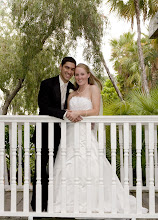Interestingly, chocolate's melting temperature is below human body temperature so as you consume it, bot the texture and the flavor change. This low melting temperature makes it easy to melt chocolate, but it is extremely susceptible to burning. The other major issue people experience while working with chocolate is seizing. If water comes into contact with the chocolate, the sugar and cacao absorb the moisture and cause the chocolate to clump, or seize. Once chocolate seizes, you can continue to add water or cream to create a chocolate syrup, but you will never be able to recover this chocolate to temper it.
The best way to melt chocolate is microwaving for a few seconds at a time (this works best if you break your chocolate into smaller pieces first) or using a double boiler. To make a double boiler, bring a pot of water to boil on the stove. Set a heat-proof bowl containing your chocolate on top, making sure that the bottom of the bowl does not touch the water. This method is more time intensive but less prone to burning.
When the melted chocolate cools, the cocoa butter creates crystal structures dependent on the temperature of the chocolate. If the chocolate cools at its own rate, the crystal structures are loose and the chocolate becomes dull, soft, and greasy. However, if you keep the chocolate at 88 degrees Fahrenheit (31 Celsius) while it cools, the chocolate forms dense crystals which are called seed crystals. If enough of these seed crystals are allowed to form, the chocolate will harden with a slight sheen and snap when bent after it completely cools. This tempering process gives the chocolate extra strength for things like flowers, sugar sculptures, and chocolate cups. It also prevents the cocoa butter from rising to the surface of the chocolate and creating unsightly discolorations. I won't go into the process of tempering chocolate here, but there are a lot of resources online if you just search for "tempering chocolate."
As a side note, candy melts (aka candy coating) that you can get in your local craft store do NOT contain cocoa butter so they do not need to be tempered.
In any event, I was among the masses of people intimidated by chocolate so I decided to take a few demos about it at this year's convention. What I discovered was the incredible ease and versatility of modeling chocolate! I will be playing around with some recipes this week so I'll post the ones I decide I like the best.
Anyway, I brought home some modeling chocolate from my hands-on classes with Bronwen Weber and B. Keith Ryder (see photos) so I played with it a bit. A LONG time ago, Shelby had asked me to make a cake for Ben's graduation - similar to the graduate hat cake, but this time with a rat in a lab coat next to it. I immediately decided to do the rat in modeling chocolate! Not only was it incredibly easy, but he smelled divine!
This is Ben's cake - an edible graduation hat sitting on top of a fondant dissertation (of course, Ben's is much thicker than this one!). The mortar board is decorated with neurons because one of Ben's neuronal images made the cover of a scientific journal! Yay! And don't forget our little chocolate murine friend!

Here's a close-up of the chocolate rat. I gave him a mowhawk because Ben had a blue mowhawk (that Shelby actually dyed for him) when Adam and I first met him. The thing on his ear is supposed to be an ear tag, which is a way some scientists identify their lab rats, but it looks more like an earing, doesn't it? I made the rat a little chubby since my lab studies obesity - he looks a lot like our rats but smells WAY better!

In Bronwen's class, we learned how to hand-model faces with marzipan, fondant, and modeling chocolate. I'll post the pictures of my faces soon, I promise!

And in Keith Ryder's class, we made a chocolate box. On the top of the box, we used chocolate transfer sheets (so fun yet so expensive, maybe I'll demo it later...) and topped it with modeling chocolate roses. He's holding my box in the picture.

Both classes were awesome, and I also attended a demonstration by Mike McCarey (you know him from the Food Network Challenge) about all the wonderful things you can do with modeling chocolate.















12 comments:
The rat is adorable, especially with all of his accoutrements. The blue mohawk is cute!
Thank again Mel for the cake!!! You did an awesome job, as usual;) hehehehe I can't wait to see everything you learned at the cake workshops!!!
~Shelby
I too, have been afraid of modeling chocolate, but have decided that I need to learn to use this. I didn't see where you posted a recipe that you like.
Thanks
How do you find out about these conventions? I'd like to learn more about chocolate myself.
This convention was the annual meeting for the International Cake Exploration Society. You can get more information at www.ices.org. They also have local chapters for each state (or country) so it's worth a looksy! :)
nice job on the rat, i am very interested in looking for more information on the cake conventions i would like to enter in. I love to bake and decorate cakes, it so great working with food that you not only can eat but you do so much with :)
I just stumbled on this page when I was Googling Modeling Chocolate and where to buy it. That Rat is adorable! And I am SOOOO jealous you got to meet Bronwen Weber AND Mike McCarey.
I cant wait to try the modelling chocolate now. Thanks for posting the information. You cake and rat looks amazing!
I am hoping to make a cat cake for my daughter's birthday and was wondering how you acheived the furry effect on your rat.
To get the furry look on my rat, I used a sharp tool (can't remember if it was a knife or a sharply pointed stick), and dragged it through the surface of the modeling chocolate in short, quick motions.
I'd love to see the faces you made with the fondant, marzipan and modeling chocolate. You did an amazing job on the rat!
These are the faces I made with the mediums: http://melcakewalk.blogspot.com/2009/08/making-faces-with-bronwen.html
Hay, I have been trying to make modeling choclocate for long, but my propotions never turn rite. And they become very hard after i place them in the fridge. Can you please tell me the exact recepice that I can try... Thanks in advance
Post a Comment